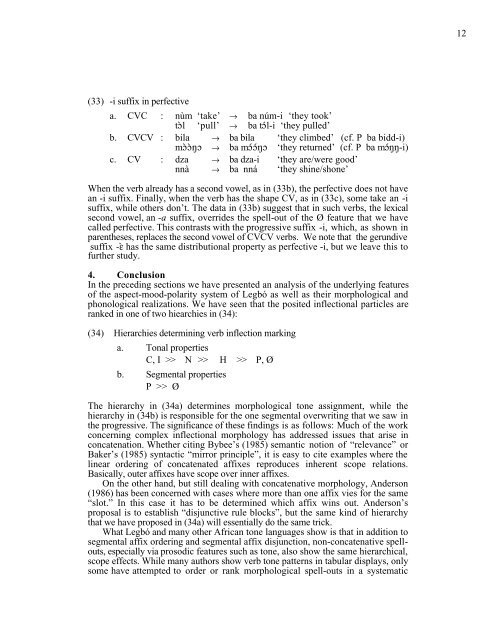Legbo Verb Inflection: A Semantic and Phonological ... - Linguistics
Legbo Verb Inflection: A Semantic and Phonological ... - Linguistics
Legbo Verb Inflection: A Semantic and Phonological ... - Linguistics
You also want an ePaper? Increase the reach of your titles
YUMPU automatically turns print PDFs into web optimized ePapers that Google loves.
(33) -i suffix in perfective<br />
a. CVC : nùm ‘take’ → ba núm-i ‘they took’<br />
tç$l ‘pull’ → ba tç@l-i ‘they pulled’<br />
b. CVCV : bila → ba bila ‘they climbed’ (cf. P ba bidd-i)<br />
mç$ç$Nç → ba mç@ç@Nç ‘they returned’ (cf. P ba mç@NN-i)<br />
c. CV : dza → ba dza-i ‘they are/were good’<br />
nnà → ba nná ‘they shine/shone’<br />
When the verb already has a second vowel, as in (33b), the perfective does not have<br />
an -i suffix. Finally, when the verb has the shape CV, as in (33c), some take an -i<br />
suffix, while others don’t. The data in (33b) suggest that in such verbs, the lexical<br />
second vowel, an -a suffix, overrides the spell-out of the Ø feature that we have<br />
called perfective. This contrasts with the progressive suffix -i, which, as shown in<br />
parentheses, replaces the second vowel of CVCV verbs. We note that the gerundive<br />
suffix - has the same distributional property as perfective -i, but we leave this to<br />
further study.<br />
4. Conclusion<br />
In the preceding sections we have presented an analysis of the underlying features<br />
of the aspect-mood-polarity system of Legbó as well as their morphological <strong>and</strong><br />
phonological realizations. We have seen that the posited inflectional particles are<br />
ranked in one of two hiearchies in (34):<br />
(34) Hierarchies determining verb inflection marking<br />
a. Tonal properties<br />
C, I >> N >> H >> P, Ø<br />
b. Segmental properties<br />
P >> Ø<br />
The hierarchy in (34a) determines morphological tone assignment, while the<br />
hierarchy in (34b) is responsible for the one segmental overwriting that we saw in<br />
the progressive. The significance of these findings is as follows: Much of the work<br />
concerning complex inflectional morphology has addressed issues that arise in<br />
concatenation. Whether citing Bybee’s (1985) semantic notion of “relevance” or<br />
Baker’s (1985) syntactic “mirror principle”, it is easy to cite examples where the<br />
linear ordering of concatenated affixes reproduces inherent scope relations.<br />
Basically, outer affixes have scope over inner affixes.<br />
On the other h<strong>and</strong>, but still dealing with concatenative morphology, Anderson<br />
(1986) has been concerned with cases where more than one affix vies for the same<br />
“slot.” In this case it has to be determined which affix wins out. Anderson’s<br />
proposal is to establish “disjunctive rule blocks”, but the same kind of hierarchy<br />
that we have proposed in (34a) will essentially do the same trick.<br />
What Legbó <strong>and</strong> many other African tone languages show is that in addition to<br />
segmental affix ordering <strong>and</strong> segmental affix disjunction, non-concatenative spellouts,<br />
especially via prosodic features such as tone, also show the same hierarchical,<br />
scope effects. While many authors show verb tone patterns in tabular displays, only<br />
some have attempted to order or rank morphological spell-outs in a systematic<br />
12

















